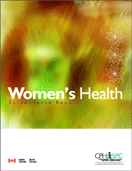
|
|


[Previous] [Table of Contents] [Next]
Chronic Pain: The Extra Burden on Canadian Women
Marta Meana PhD (University of Nevada), Robert Cho, Marie DesMeules MSc
(Health Canada)
Health Issue
Chronic pain affects individuals of all ages and ethnic backgrounds as well as both
sexes. It is a major public health problem, associated with deficits in quality of life,
difficulties in psychological adjustment, depression, disability and reduced income
potential. The economic cost of chronic pain to society is huge in terms of health
care utilization, absenteeism from work, disability, high levels of medication
dependence, and the failure of multiple and often expensive medical procedures.
Epidemiologic, clinical and experimental studies have all consistently found that
the burden of pain is greater for women than for men.
Key Findings
- According to the self-report data of the Canadian Community Health Survey (2000), 16% of the population aged 12 years and older suffered from chronic pain (14% males versus 18% females).
- The prevalence of chronic pain increased with age in both sexes.
- Pain intensity was similar for males and females.
- There was an association between chronic pain and income: its prevalence was lower among those in higher income categories.
- When age, income and education were controlled for, women were not at greater risk of chronic pain than men.
- The prevalence of depression was twice as high among people reporting chronic pain as among those who did not, and among the former it was twice as high among individuals aged < 65 than those > 65.
- The majority of those who suffered chronic pain were limited in at least a few activities directly because of the pain; the proportion was higher among females (77.7% versus 70.7%).
- Among people aged = 65, the proportion of south Asians who reported chronic pain was higher than for any other ethnic group; for those aged < 65, Aboriginal Canadians had the highest proportion of chronic pain.
Data Gaps and Recommendations
The authors identified the following data gaps and made the following recommendations:
- There is a lack of detailed information on the types of chronic pain that women experience, for instance chronic pelvic pain and other pain associated with reproductive function.
- Data from sources other than self-report surveys are needed, such as provincial databases of billing claims or Pharmacare data. These would provide a clearer picture of health care utilization and patterns of analgesic medication use.
- There has been little investigation into the effect of chronic pain on domestic responsibilities and parenting, areas that tend to be ignored in assessments of the impact of health conditions in women.
- Surveillance and early identification of pain disorders is crucial to reducing their impact, since early treatment is likely to result in better outcomes.
- Assessment of pain should be incorporated into the first medical consultation with either primary care providers or obstetricians/gynecologists and repeated periodically.
- Patient education and self-management approaches must be part of the strategy to combat chronic pain and its effects on health care services, particularly given the large expected increase in the number of individuals over the age of 65 in the next 30 years.
[Previous] [Table
of Contents] [Next]
|




